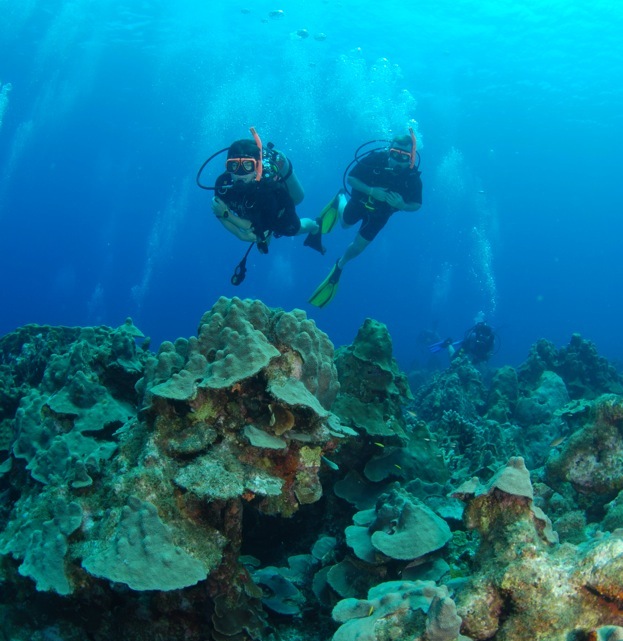Professionals will bring you to the best dive sites of Curaçao and will take care of reliable guidance. All you have to do is enjoy the peaceful and unforgettable dive experience. So dive into the relaxed and inviting atmosphere of recreational scuba diving and discover the sensation of hovering amongst colourful fish and beautiful coral.
This dive site has been rated as one of the Caribbean Best Dives by Sport Diver Magazine. Over time hard coral formations have grown in such a way that they resemble mushrooms, hence the name. The Majestic Star and Boulder coral rise up to form mushroom-shaped domes full of underwater life. After entering the water, you dive around large boulder coral formations, where critters hide under the ledge.
Dive Spot for Macro Photography – Reef Dive, Boat Dive
Dive Level: intermediate
Dolphin Boat Dives
A unique diving experience provided exclusively in Curaçao by Ocean Encounters Diving and Dolphin Academy. After a short dive briefing and dolphin interaction briefing you’ll gear up and take a short boat trip to shipwreck point. After entering the water and starting your dive you will be met by the trainer and the dolphin(s). Be prepared to smile the entire dive!
Dive time: 45-50 minutes dolphin time varies around 20-30 minutes.
Dive Level: easy to intermediate. Bring your camera, they love attention!
Klein Curaçao and East Point
East Point, an unspoiled, lush and pristine spot where turtles, rays, large fish, sharks and so much more can be seen.
They say that in Klein Curaçao underwater everything is bigger and there is more of it. A true Caribbean dive location, this boat trip is for divers only.
Dive Level: intermediate to advanced
Southern Rays, and Turtles.
Here is a mini profile of Five Top Dive Sites:
Lost Anchor
A favorite Curaçao Dive Site, bright and colorful. This reef on the rough side of Caracasbay is not easily accessible, but the dive on Lost Anchor makes up for it. Beautiful lush wall covered in gorgonians and sea fans. Dense coral growth hides an anchor chain that goes on forever. The dive finishes on a shallow edge where sea horses like to hang out. Great dive for macro photography.
Beacon Point
Currents make this site and intermediate to advanced dive. Largest pillar coral formation in the Caribbean at this dive. In the blue you can find large jacks, grouper and barracuda chasing around after they’ve eaten.
The Corner
Lush, full of life, gorgonians gently swaying in the current… This healthy reef is packed with sea life. Racing jacks and barracuda with intense eyes will accompany you throughout your dive. Blue Creole Wrasses swarm towards their daily afternoon mating meetings.
Newport
This beautiful and pristine Curaçao dive site is only accessed by Ocean Encounters Diving based in Curaçao. A beautiful slope with great star coral, brain coral, and soft gorgonians. Eagle rays and turtles are spotted frequently.
Small Wall
The name says it all, it is a wall and it is small. Overhangs and little nooks house schools of soldier fish, grunts, and damsels protecting their gardens and eggs. Lush gorgonians and sea fans wave in the soft current.
Wreck Dives
Superior Producer: all levels
In 1977 the superior producer was on its way to Isla Margarita, when it came into the harbor of Curaçao to take on fuel and supplies. As the ship continued its voyage it ran into trouble exiting the harbor. Due to rough seas, part of the cargo shifted and as a result the ship listed and started to take on water. The ship was towed to the north of the harbor entrance where it finally sunk just of the coast of Otrobanda.
The wreck measures about 50 meters in length and sits upright on a sand plateau only 60 meters away from the shore, at a depth of about 30 meters/100ft. The deck and the entrance to the cargo hold are at a depth of about 25 meters/80ft. The shallowest part of the wreck is the top of the super structure which is at around 18 meters/40ft depth.
After all those years on the bottom of the ocean the wreck is now completely covered with many different species of corals and sponges. One species of coral, the orange tube coral, does very well under low light conditions and covers much of the wreck. The polyps of this coral are bigger than the other corals and when they extend during the night to catch food, the wreck turns orange.
Tugboat: advanced
The wreck of the tugboat rests upright at aprox 6m/18feet on the southernmost point of an extensive sand plateau at the Caracas Bay Island. During the years the wreck became fully covered with many different coral formations and colorful sponges. The dive spot is sheltered from the elements so the diving conditions are near perfect. There are hardly any waves or current at the wreck.
Just around the corner in a southeasterly direction you will find a steep wall which drops down to 30m/100feet depth. When you dive on the wall you have to keep in mind that here there could be current with considerable strength. The top of the reef and the shallow part of drop off are fully covered with corals and sponges. The wall has less coral coverage but has many small crevices and holes which hold many small creatures like crabs and several species of nudibranchs.
At the end of the adventure it is well worth the trouble to dive to the pier next to the dive centre. The steel pillars are fully covered with corals and sponges and hold a lot of small underwater life such as shrimps, gobies etc.
















No Comment